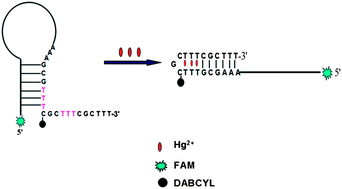Simple and highly sensitive molecular beacon probe based on target-induced structure-switching DNA for mercury(ii) detection
Abstract
A simple and highly sensitive molecular beacon (MB) probe, based on coupling target-induced conformational switching of DNA hairpins with thymine–Hg2+–thymine (T–Hg2+–T) coordination chemistry, was designed for the determination of mercury(II) (Hg2+). In this MB, the DNA hairpins contain a stem of 6 base pairs enclosing a 27 nucleotide (nt) loop and an additional 12 nt sticky end at the 3′ end. The twelfth base from the 3′ end was labeled with a quencher of 4-(4′-dimethylaminophenylazo) benzoic acid (DABCYL), and the 5′ end was labeled with a fluorophore fluorescein amidite (FAM). In the absence of Hg2+, the DNA hairpin is in a closed form resulting in fluorescence quenching. In the presence of the target analyte, Hg2+-mediated base pairs induce the conformational change from the sticky end to open the hairpins; the fluorophore and the quencher are moved away from each other, leading to the restoration of fluorescence. The dynamic concentration range was from 0.5 to 50 nM Hg2+ with a detection limit of 0.3 nM at the 3σ level. The assay strategy afforded high selectivity for Hg2+ against other environmentally related metal ions. The developed method is very simply, only requiring a one-step reaction to realize the assay of Hg2+.


 Please wait while we load your content...
Please wait while we load your content...